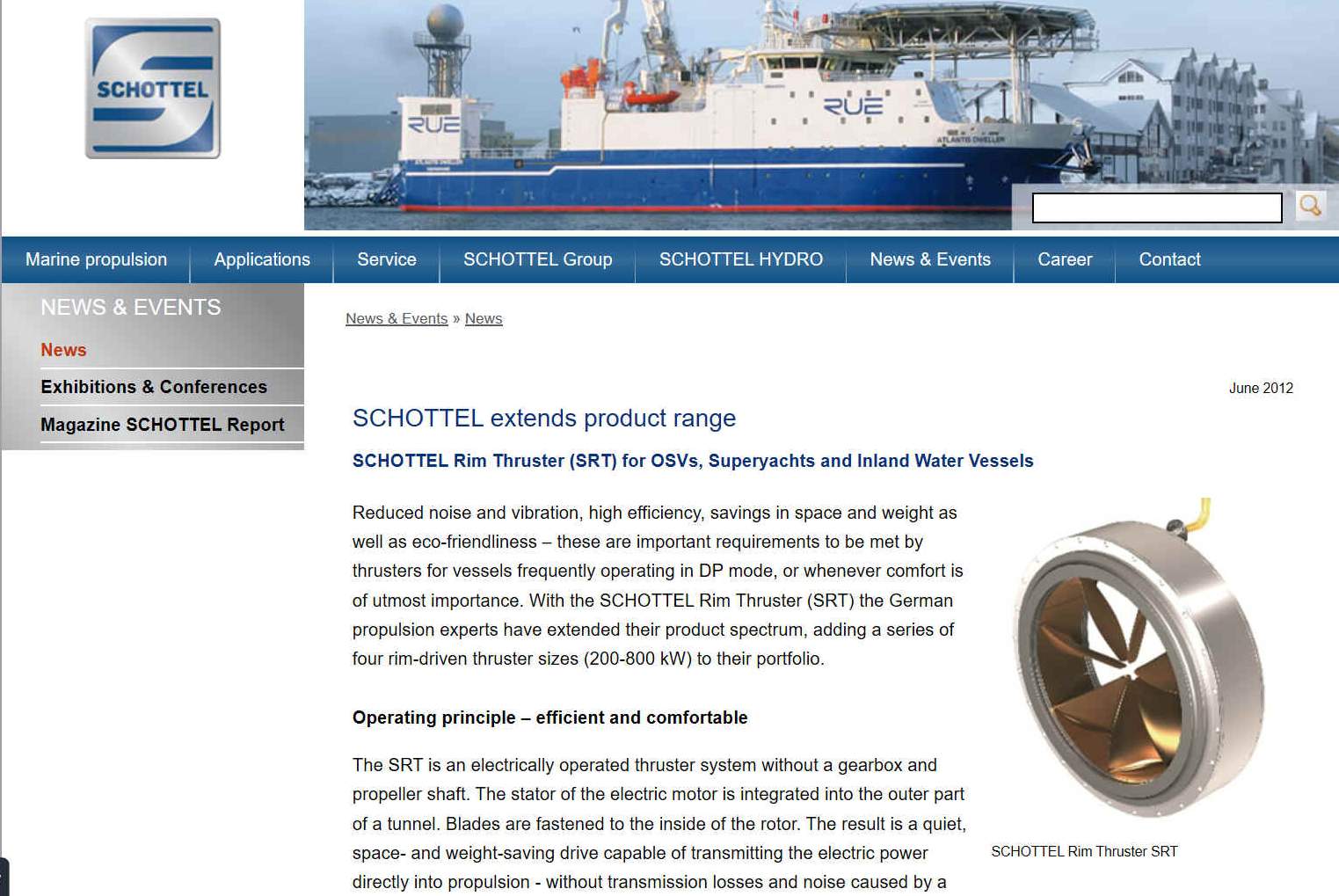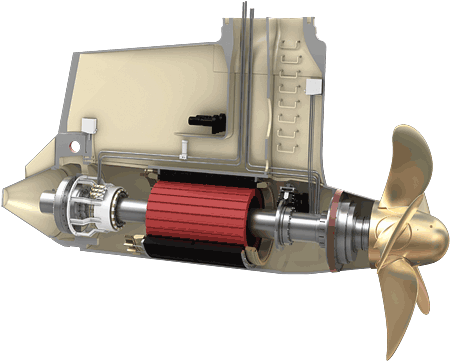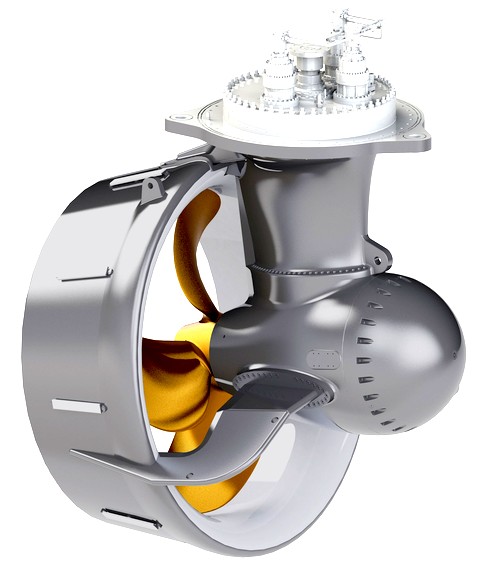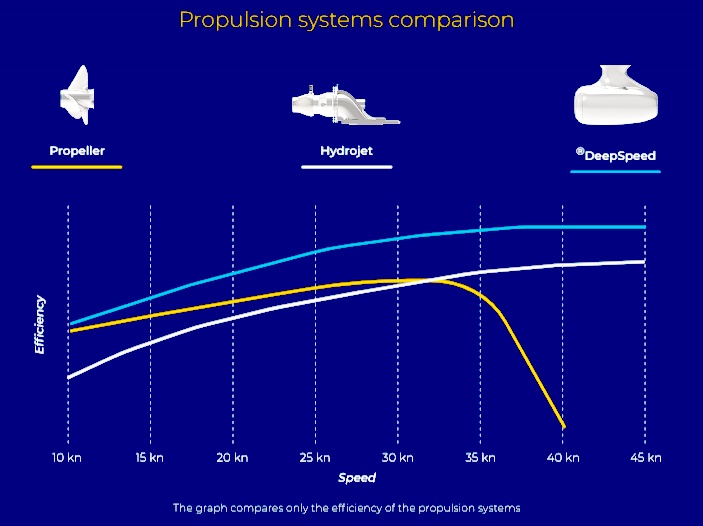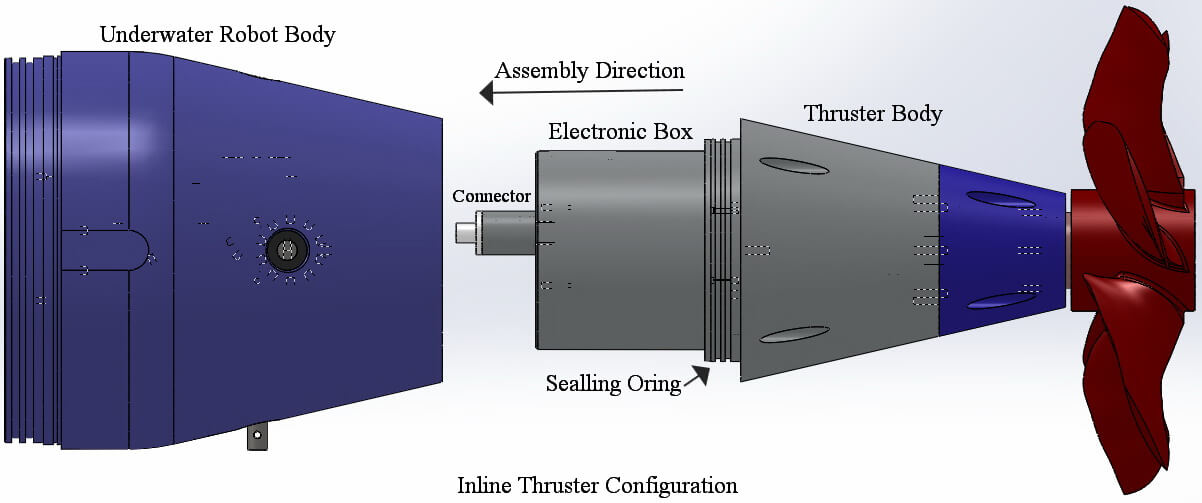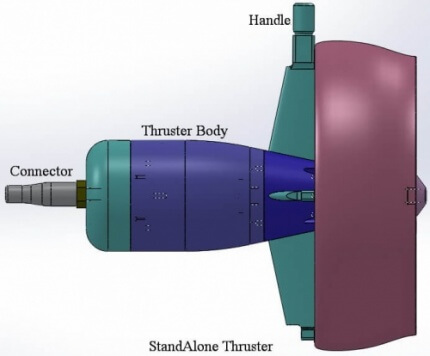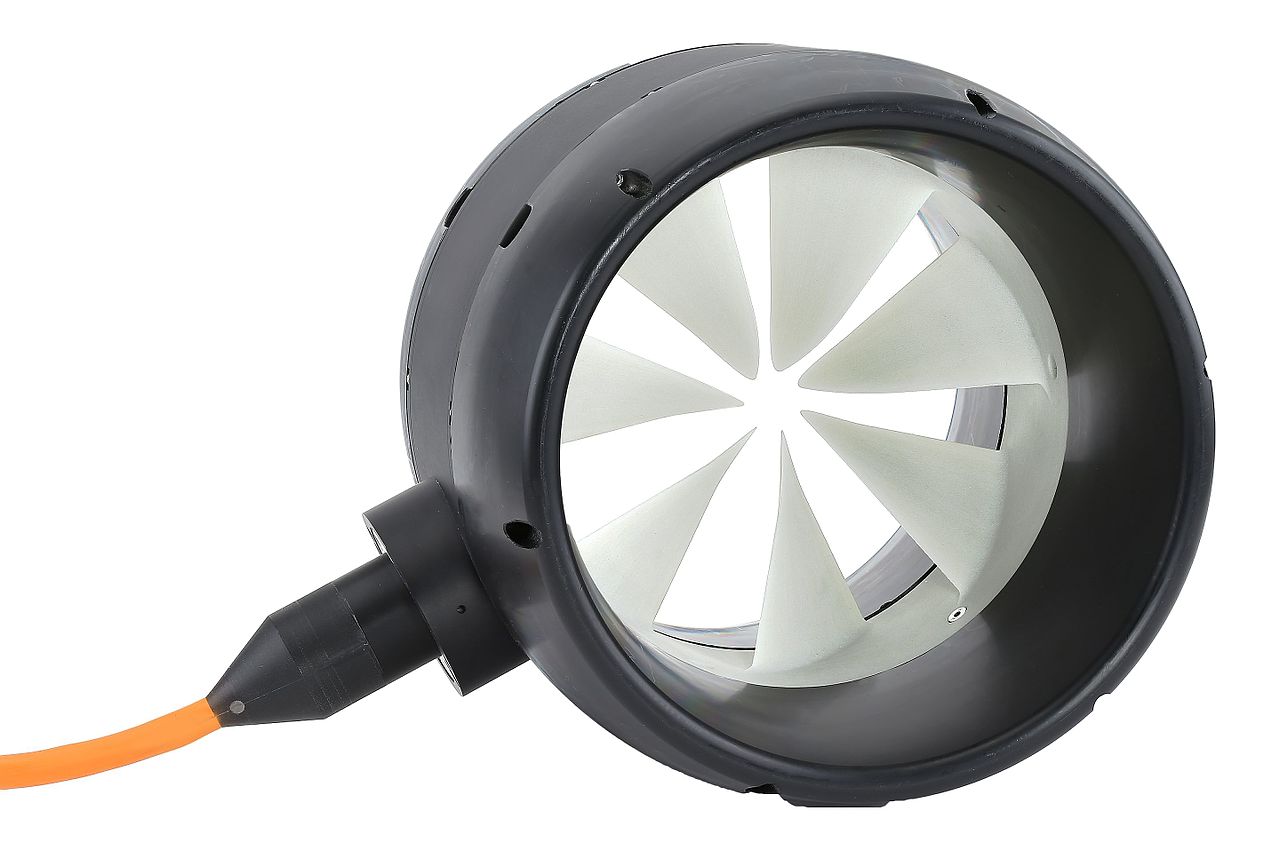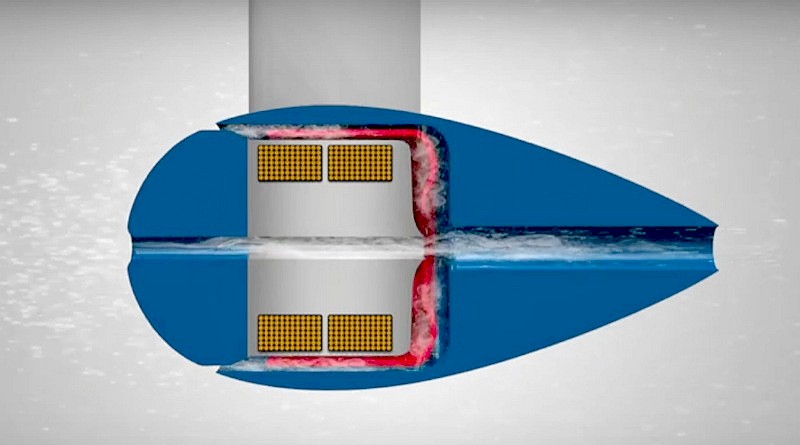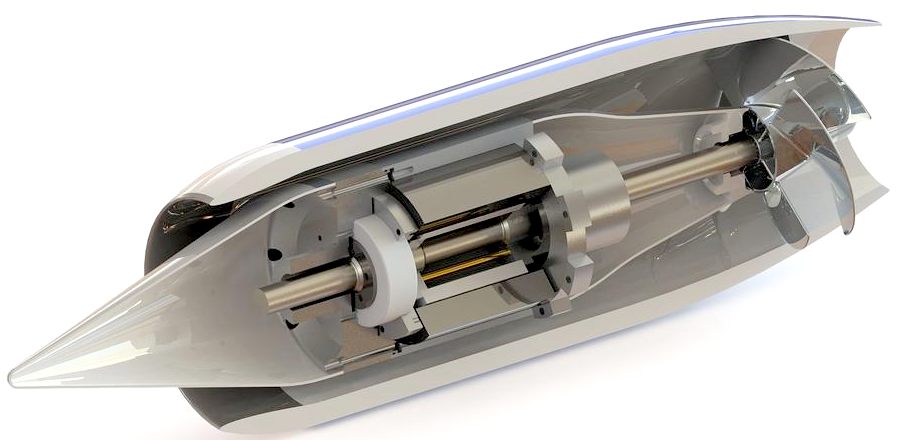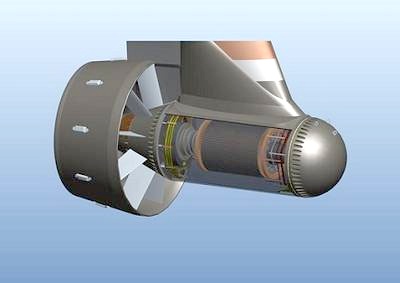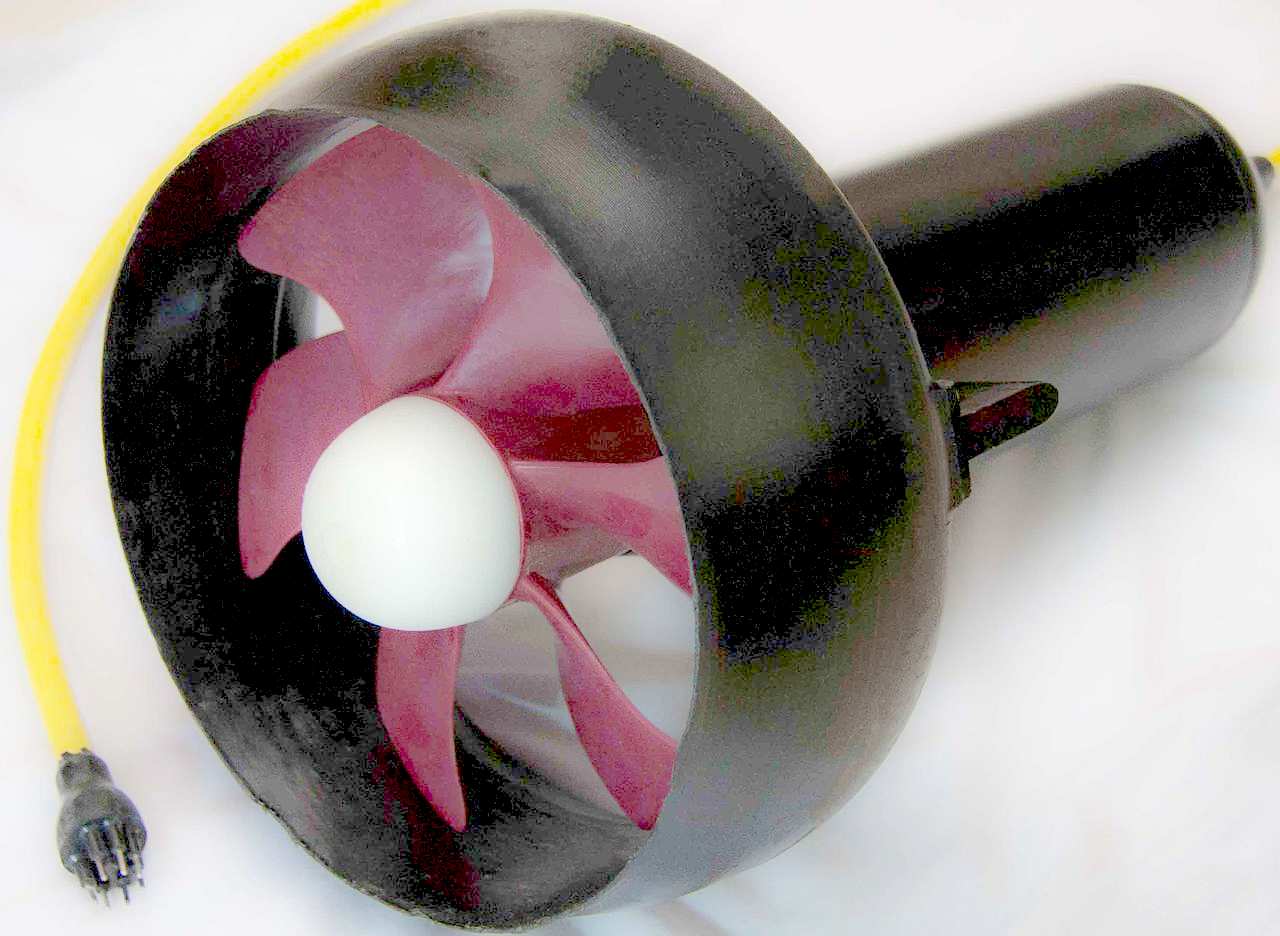|
ELECTRIC JET (RIM) THRUSTERS & FINS
Please use our A-Z INDEX to navigate this site where page links may lead to other sites
|
|
SCHOTTEL
- The Rim Thruster (SRT) is an electrically operated thruster system without a gearbox and propeller shaft. The stator of the electric motor is integrated into the outer part of a tunnel. Blades are fastened to the inside of the rotor. The result is a quiet, space- and weight-saving drive capable of transmitting the electric power directly into propulsion - without transmission losses and noise caused by a gear box. The optimized hydrodynamic design with the blades inside leads to a considerable reduction of cavitation.
Then along came the electric motor for outboards. The designers soon dispensed with the motor where it would have been if it was a petrol engine above the transom, with a shaft to a bevel gear to drive the propeller. Instead they put the electric motor in a waterproof pod and the propeller on the end of the shaft directly, thus saving a few percent in gear losses.
Small submarines and drones have been using thrusters for years now, as have large ships as through hull bow-thrusters. As climate change looms to sway politicians to consider zero carbon shipping, the logic of continuing to use classic designs for propellers, or rather propulsion, is questionable where ships will end up being electric, and more than likely powered by wind turbines and solar panels.
At this stage underwater pods with high efficiency are sure to take off. Indeed, the Cleaner Ocean Foundation are looking at what is on the market with a view to incorporating in designs for zero emission workboats and cargo ships of the future.
Some of the most promising designs do away with the conventional hub motor and shaft that drives a propeller, replacing that with a rim mounted motor, that is built into a (necessary) shroud in Kort fashion, meaning that the torque potential is also improved where direct drive is the order of the day, and the water flow is more linear. The next advance might see stator blades. At least, that is how we read it.
The fact is, there is still room for improvement. The IMO and G20 may want to put some money into such development.
MEETING OF MINDS - The innovator and the professor. William Gobbo (left) with Professor Ernesto Benini
The DeepSpeed outboard electric water-jet engine has a power of 120 kW, or 160 hp. At 40 knots, a yield equal to that of a 260 hp propeller engine is estimated, with an expected efficiency of 83%. By moving the propulsion unit outside of the hull and by making the motor a rim-drive leaving the water stream uncluttered, do "you gain between 20 and 30% efficiency", according to the developers.
The most interesting comparison is that between the outboard jet and the propeller. At 20 knots, the former has a theoretical efficiency of 65%, against 52% of the propeller. But it is between 35 and 40 knots that the gap widens: the efficiency of the propeller decays, while that of the outboard water jet stabilizes, according to mathematical models, "above 80%".
The concept came about because the price of replacing a V8 fossil fuel motor on a boat owned by DeepSpeed founder William Gobbo in 2007 got him thinking that there must be a better, cleaner solution to getting a boat through water.
He looked at electric motor options and saw they all had propellers which then got him to wondering why there wasn’t anything like a jet engine as an option. After all, airplanes had ditched propellers for turbines decades ago. There must have been a reasons. Why was boating still stuck on propellers?
Assembled an international team of experts
Sr. Gobbo’s expertise was actually in the banking and information management industry, not engineering, so he began to ask others who did know engineering and gathered a team around him that now includes experts in fluid dynamics, mechanics, electronics, computer science, design, communication and prototyping. They come from six countries and there there are 2 professors, 2 researchers, 11 engineers, 4 designers, an 1 F1 H2O powerboat pilot…and most importantly, one luminary.
The luminary is Professor Ernesto Benini of the University of Padua a leading international expert on fluid dynamics experts applied to aeronautical propulsion.
Professor Benini immediately saw that the idea of positioning a water jet engine as an outboard overcame all of the limits of traditional water jet propulsion systems (whether gas powered or electric) which were all positioned inside the hull of the boat.
The biggest difference is that the inlet flow of water becomes dynamic. With jets inside the hull the flow is static, determined by the motor only, but with an outboard jet the water flowing through the jet as it moves through the water creates a dynamic flow: it increase with speed. In essence the faster the boat goes…the greater the flow…the faster the boat goes – and with increasing efficiency.
COMPARISONS
- The difference in efficiency compared to a propeller is even more stark, as this chart shows.
So much enthusiasm that Benini immediately joined the team, which resulted in increased interest from investors and Italy’s scientific community as a whole.
In 2018 the DeepSpeed propulsion system achieved “Seal of Excellence” certification from the European Union’s Horizon 2020 department, which is only given to 3 out of 1,000 applicants. This in turn has led to investments of almost €1.2M from various Italian and European
science, technology and startup funds. They are in contention for a Horizon loan of €2M and DeepSpeed’s facebook page has notification of a
crowd funding effort, but no details have yet been posted.
Who knows, maybe a waterjet on the outside of a boat is another one of those ‘let’s start with a clean sheet of paper’ ideas that will propel (pun intended) electric boating even more quickly into widespread adoption.
MAIN
COMPONENTS OF A MODERN ELECTRIC THRUSTER: 2. Propeller: The propeller is the component which converts rotation to thrust. Selection of the right propeller has a considerable influence on the performance a thruster. Each application's hydrodynamic load line needs a matched propeller for maximum efficiency, but there is lack of standard off-the-shelf propeller variation on the market and therefore it is impossible to order the thruster with the best efficiency propeller. Some companies will design and develop custom propellers, but their prices are really high. Other companies try to offer many propellers as options and let the user select the best one using performance charts of their thrusters.
DECEMBER 12 2019 PLUGBOATS
-
Amazing new electric boat motor based on fish fins
The FinX motor is one of the exhibitors in the booth of the AFBE (Electric Boat Association of France) at the show. “We replace the propeller with a membrane that ripples like a fish fin,” CEO and Founder Harold Guillemin explained to the AFBE. “It’s a technology that comes from industrial and medical pumps that we have licensed to the nautical field.”
Electric boat motor inspired by nature
M. Guillemin is a 28 year old mechanical and and electrical engineer who has been convinced since his teen years that “the best way to preserve nature is to be inspired by it.”
While working at AMS R&D on their Wavera membrane pump technology the thought occurred to him that since Wavera was based on the movement of a fish fin, wouldn’t it make sense to use it to propel a boat?
Technology in use for industrial and medical
The membrane pump was originally designed to be used in industrial applications, but it has also been miniaturized by medical supplier Corwave for a cardiovascular pump that mimics the action of a patient’s real heart.
Rather than try to explain how the FinX motor works, we’ve borrowed an animation from Corwave and a video from Wavera. The animation shows the basis of the design and the video shows how the fish fin actions works as a circular membrane.
One of the advantages of FinX technology is its efficiency, comparable in some ways to the Deepspeed hydrojet motor being developed in Italy. The FinX is 20 to 30% more efficient than propellers.
More efficient, nothing to get tangled
Another advantage is that no propeller means more safety for swimmers (and fish) and nothing to get tangled or caught up in its working. A video on the FinX YouTube channel shows it in a tank of polluted water to demonstrate how things like algae, plastics and fishing line pass through it.
For future plans, M. Guillemin told the AFBE “In the second half of 2020, we would like to have available a higher power range that would be around 150 horsepower.” He also said they would like to approach other engine manufacturers about licensing the FinX technology.
INTERESTING CONCEPT - Looks to us as if there is room for improvement in this design, where a 90 degree bend in any pipework absorbs power and may put a strain on the membrane at the turn. At least that is a common sense analysis. It still works though.
KEY DESIGN CONSIDERATIONS WHEN CHOOSING A THRUSTER
1. THRUST: The ultimate desired feature of a thruster is THRUST.
2. HOW MUCH THRUST: The size and mass of the vessel will determine how much THRUST is needed to move a vessel. Other key factors are hull efficiency. Hence, the drag of the vehicle must be known, or estimated as accurately as possible.
MOTOR SIZE: The Electrical Power is set by the Thruster. The size of the Motor will now depend how this Electrical Power is generated. Electrical POWER = Voltage x Current. This means that if the VOLTAGE is LOW, then the CURRENT must be HIGH.
VOLTAGE VARIATIONS: Motors can be designed to work precisely at very efficient levels if all parameters remain the same. However, in MANY cases, the bus voltage can swing over a wide range. This is particularly troublesome at low voltages (ie. 100-150V) which naturally occurs in Battery systems.
Power at MAX or MIN Voltage: The designer has the option to require the MAX POWER level at MAX Voltage, or at MIN Voltage. If this power level is required at MINIMUM Voltage, this requires a motor with much more current capacity, which affects size & weight. If this is only required at MAX Voltage, this will require lower currents, which can reduce Motor and Electronics Size & Weight, but it will mean that the net output power (and thrust) will drop slowly as the voltage level reduces.
MARINE LINK MAY 2013
A - Z SAIL AND SOLAR ASSISTED BOATS & SHIPS
LINKS & REFERENCES
http://voith.com/corp-en/industry-solutions/marine-technology.html http://sut.org/ http://lianinno.com/underwater-thrusters/ https://www.marinelink.com/news/breakthrough-electrical354225 https://www.ilsole24ore.com/art/deepspeed-l-idrogetto-elettrico-che-mandera-pensione-l-elica-AC9KCid https://www.copenhagensubsea.com/ https://plugboats.com/an-italian-hydrojet-to-revolutionize-electric-boats/ https://plugboats.com/amazing-new-electric-boat-motor-based-on-fish-fins/ https://en.wikipedia.org/wiki/Underwater_thruster https://en.wikipedia.org/wiki/Pump-jet https://www.instructables.com/id/ROV-Thruster-105-Lbs-From-DT700-Brushless-Motor/ http://www.gepowerconversion.com/
Please use our A-Z INDEX to navigate this site
|
|
|
This website is provided on a free basis as a public information service. copyright © Climate Change Trust 2021. Solar Studios, BN271RF, United Kingdom.
|
